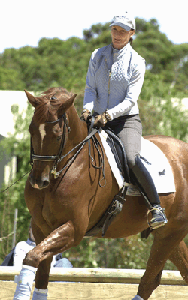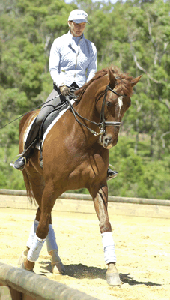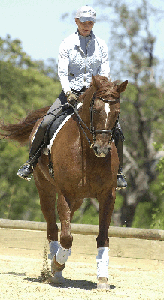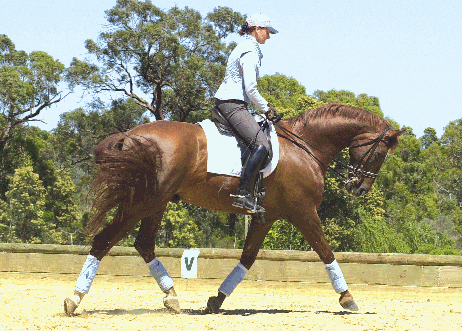Sit on the fence once again and watch master German dressage trainer, Martina Hannöver work with some Australian dressage riders and their horses. Each presents a very different challenge to the trainer and the rider.
Emperor Charlemagne returned to the ownership of Kate Foundas after a break of four years spent in Sydney with Claudia Harper. He is working at Prix St Georges level.
Older means more experienced, it also means craftier -and ‘Charlie’ has a whole bag of tricks to keep the rider under his control, but Martina is quick to spot the problem:
“He’s trying to push you to the outside, you’ve got to sit to the inside. Keep your hands together; sit to the inside with a long inside leg and quiet hands. Let your tummy come out a little more. Try to make him longer in the neck, let him follow your hands down. Try to sit with both seat bones into both hands. If you don’t sit straight, your horse can’t be straight.”
“When you sit straight he tries to throw you to the outside, and you try to balance with your upper body and you end up sitting too much on one side.”
“When he is not accepting the rein, take a little more steady contact, don’t make him too light – use many half halts to make him more through. Keep him busy on the outside rein with many half halts. Play with the bit, show him the way down deeper, make him more open in the back.”
Like many horses, Charlie tended to react to the spur by backing off the hand and hollowing: “when you come with the spur, he comes back at you. Say NO we just go forward.”
And when he does go forward, there is a little hump, nothing scary, just a case of the ‘I don’t want tos’ – and the solution?
“Go forward, it doesn’t matter if he is disunited, go forward whatever happens. You are the teacher, you have to tell him what to do – but he must DO SOMETHING. He was kicking to the spur and you pulled him back and spurred again. We want him going forward on a flat leg, not with every move from the spur. A quiet flat leg.”

“Now sitting trot, and if he gets tense, go back to rising trot until you can sit into him.”
Time to work on some circles.
“How do you turn to a circle? It is not a car or a bicycle, you must turn him to the circle around your inside leg.”
And from the circle we move to half pass:
“Half halt on the outside rein for the half pass. How does he know to do a half pass if you are not giving half halts on the outside rein? Keep going half halt, half halt, half halt, until you finish the half pass.”
Back to the canter:
“Always when you feel you are losing the rhythm go to a forward moving canter, get the rhythm and bring it back to a collected canter. Now he is forward and open, you can come with the whip and his hind legs will step more under him, but don’t start with the whip. In the beginning make him listen to the leg, then ask with the whip.”
It was time to put Charlie away for the day, time for Martina to reflect on the use of the whip…
“So many people here in Australia seem to need the whip. I don’t know what for. They don’t seem to wake them up with the whip, they make them more and more tense – they use the whip too early in the session, when the horse is not yet able to step more and more from behind into the steps of the front legs. They try to help out with the whip but it doesn’t work, you have to give the horse enough time to become loose and relaxed and open with all his muscles. Then you can use the whip to encourage them to step a little bit more under if they aren’t listening enough to your legs.”
“The problem with many Australian riders is that they press a lot with their legs, they press every little step and they press the movement out of the horse. If I press you all the time, then you will get tense. What we try to do is make them a little bit sharper on the leg, then if you need help, you have the spurs, then you need your ‘flat leg’ for the exercises.”
“That’s how it should be, not that you make them sharp and responsive in the exercises, you make them sharp in the normal basic work and then try to ride the exercises – the dressage movements – with not so much spur, more on the flat leg, so the exercises can be loose and in the normal rhythm.”
What is a flat leg – a quiet leg?
“No, I mean a flat leg. Most Australian legs could be more quiet, that’s true, but too many riders ride with the spur, with the toe turned out. They should watch that the knee is not pressing on the horse, but the knee is just on the saddle, and the foot is parallel to the horse. A flat leg.”
With Charlie at the beginning, he seemed to be sucking back a little from the aids, behind the rider?
“Especially in the neck the horse was trying to make himself very comfortable, and he was too light in the hand. The rider was not straight in the upper body and with both hands together – she was always trying to pull with her left hand on her left leg, so the horse was not straight also.”
When he humps up on the spur, you don’t back off, you make him go more forward?
“Yeah because he was getting more and tense. She wanted a reaction, to go more forward, and he was going forward but he started to kick to the spur – and she took him back! It’s like a car which is not moving, you can’t use the brakes. If you want to give half halts you have to have the horse in front of your leg.”
Result?
“I was happy with the result. I think the rider felt that she must sit straight on the horse and keep her hands and her legs under control, and the horse looked so much happier, not getting more and more tense. He was going forward by himself, and the exercises were no problem – just one or two half halts more, or maybe thirty or forty, but first we got the basics, that the horse really had a nice trot and canter, stepping more over with his hind legs in front of the forelegs – and that shows us that the body has really started working, using every muscle, every tendon, he started to use his whole body.”
Next month we meet three horses – one old friend of Martina’s with a flying change problem, and one absolute baby having about her tenth ride since coming back from the breakers, and her first outing to a clinic. The other a young stallion that has been going well in young horse classes.




